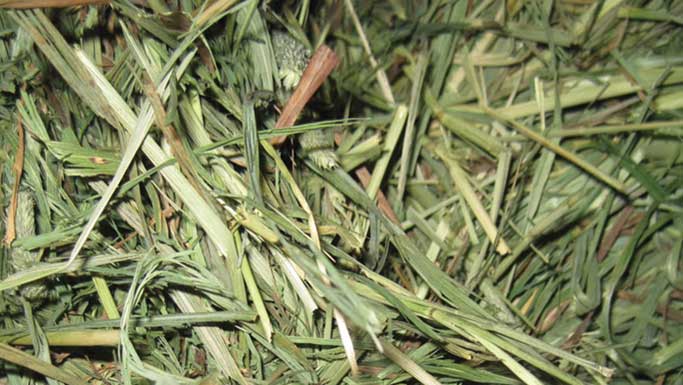While the horse is still at the veterinary clinic, your veterinarian will want to start feeding him as soon as possible to encourage normalization of gut movement and reestablish the microbial ecosystem. Typically, this will start with some highly palatable fibrous foods such as soaked alfalfa cubes or seniors’ feed. Eventually the horse will be readapted to more typical long-stem hay and will be ready for release.
Once your horse is back home, you’ll have two goals – to prevent colic from happening again, and to manage any damage or surgical issues within the intestines themselves. In terms of prevention of colic, the general feeding and management guidelines include offering fresh, clean water at all times and providing the horse with good quality forage. For a post-colic horse, you want to look for hay that is very leafy and not too fibrous. This will further help to stabilize the microbes, while decreasing the risk of an impaction.
Moving forward, minimizing the amount of concentrate (grain or grain mixes) fed to the horse can also help decrease the risk of colic. For horses that need those calories and other nutrients, feeds like beet pulp, rice bran, vegetable oil, and soybean meal can be mixed to offset the amount of concentrate fed. Of course, you would also need to deal with any intestinal parasites, sand, or other risks according to your veterinarian’s guidelines. And as always, any changes made to the horse’s diet should be done slowly over several weeks.
Feeding the part that works
In many cases of colic surgery, some of the digestive tract might have been removed because it was damaged by the colic incident. Typically, either some small intestine (usually the ileum, the last part of the small intestine) or the large intestine (some of the large colon) has been removed. Because these different parts have different functions, it is important to feed the part that still works, especially if a large amount of tissue has been removed.
For example, if some of the ileum has been removed, that will mean that the small intestine that typically digests and absorbs simple carbohydrates, protein, minerals such as calcium, and fats may have limited capacity to digest these items. You’ll want to feed the part that works; therefore, you should feed highly-digestible protein sources like soybean meal or alfalfa, limit the non-structural carbohydrates in the diet, and limit fat. However, the horse will need the fat-soluble vitamins (A, D, E and perhaps K), which may need to be injected directly. Ample calcium should be included in the diet to ensure enough is absorbed by the limited capacity of the small intestine.
In terms of large colon resection, because it is so large, a small removal may have little impact on the horse’s nutritional status. However, if a large amount has been removed (>50%), the capacity of the horse’s hindgut to ferment and digest fibre will have been compromised. Therefore, the horse should be fed highly-digestible simple carbohydrates, with fats providing a good portion of the calories as well, to decrease dependency on the large intestine. The horse may also need to be supplemented with additional phosphorus, which is absorbed in the large intestine.
Depending on the complexity of the surgery, the prognosis for many post-colic cases is very good as long as the horse receives excellent nutrition. Working closely with your vet and equine nutritionist will help provide your horse with a dietary strategy that will provide all the nutrients he needs, while facilitating the healing processes and minimizing the risk of another colic.

